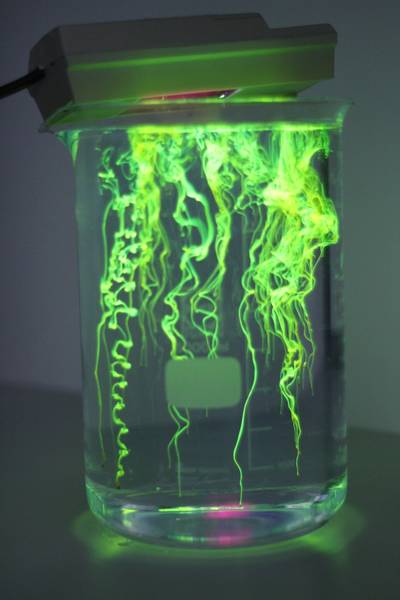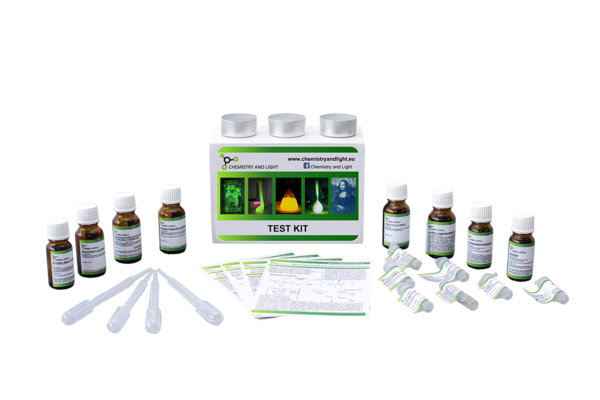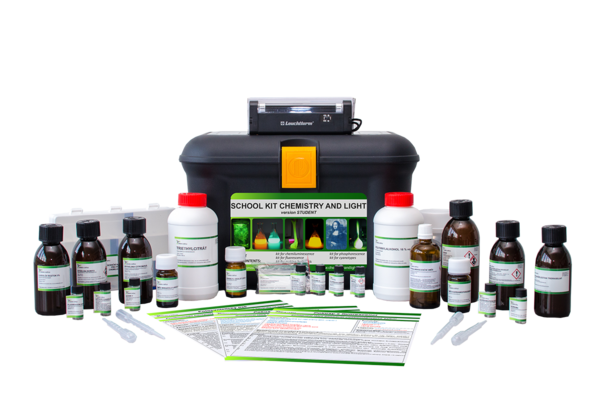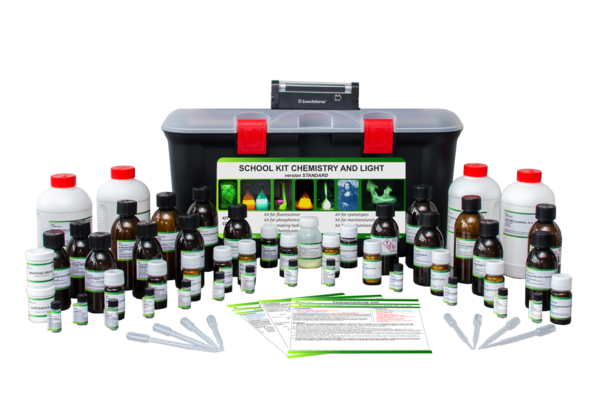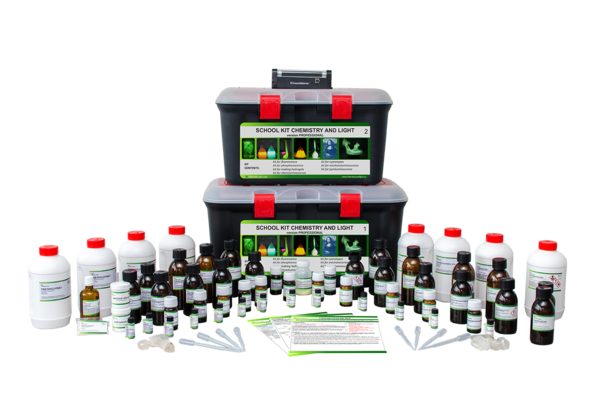Attractive and safe chemical experiments linked to educational programmes
Fluorescence
Fluorescence is a physical phenomenon during which a material is electronically excited by absorption of a quantum of electromagnetic radiation and subsequently emits light. Fluorescence represents a subcategory of cold-light emission – luminescence.
The origin of fluorescence is related to the material´s ability to absorb electromagnetic radiation and subsequently release the extra energy in form of a characteristic emission radiation. The irradiated material enters a so called high energy “excited state”. The return from the excited state to the ground state is linked to the emission of a photon. When this happens instantly (<10-8 s), we speak about fluorescence.
The wavelength of the excitation radiation is almost always shorter (and therefore higher in energy) than the emission radiation. (There are only very few exceptions to this rule).The typical examples of the excitation radiation are light in UV region, visible light, X-Rays and radioactivity. In the latter case we speak about the so-called radioluminescence.
The materials that undergo fluorescence can have a vast array of structures, but generally speaking, the organic fluorescent compounds usually incorporate a system of alternating single and double bonds (conjugated bonds). The arena of these compounds is clearly dominated by molecules with aromatic benzenoid structures.
The first observations of fluorescence can be traced back to Medieval Ages. At that time, exotic materials (spices, woods, etc.) were imported to Europe and used in medicine. Nicolás Monardes, a Spanish physicist and biologist observed at about the same time as the Franciscan Bernardino de Sahagún the remarkable optical properties of the extract of the wood of the bush Eysenhardtia polystachia and the similar plant Pterocarpus indicus from Philippines. Both plants were called “lignum nephriticum” (“kidneywood”) because the extract from this wood proved helpful in treatment of kidney diseases owing to its diuretic effect.
When a dried kidneywood was left to infuse in clean water, soon a beautiful, bluish colour tone appeared as a result of the fluorescence of flavonoid compounds (matlaline) contained in the wood. This effect was best observed in a partially darkened room. Products made from this wood, especially wooden cups, used to be a curiosity on noblemen´s courts.
A similar, but much better known example of a fluorescent wood and bark with a therapeutic effect are cinchona trees. Cinchona alkaloids (quinine being the best known of all) are used as additives in tonic beverages and as a medicament against malaria (although there are nowadays better alternatives).
Fluorescence finds a range of essential applications as you can see in the bottom part of the mind map (part of the kit – see the preview). The economically most important role lies in illuminating technology, for instance the energy saving lamps are based on fluorescence. The heart of most fluorescent bulb contains traces of mercury vapour, while the inner side of the tube is covered by a suitable solid luminophor. Passage of electrical current excites the mercury vapour that subsequently emits UV light. The UV light then excites the luminophore on the walls of the tube which in turn emits visible light. Slight modifications in the chemical composition of the luminophore can alter the chromaticity of the emitted light.
The new trend of the past 10 years in illuminating technology is the growing use of electroluminescence diodes known as LED´s (Light Emitting Diode). The emission of light is caused by recombination of electrons and holes in a semiconductor material of the diode. The energy of this recombinations excites the photoactive diode material that is responsible for the characteristic light emission. A broad variety of light colours can be obtained by a suitable choice of photoactive materials. The significant advantage of LED´s is their high efficiency in conversion of electricity into light.
Iluminating technology aside, the other major application of fluorescence is the use of fluorescent dyes. Depending on their structure, these dyes can be either fat-soluble or water soluble, provided they contain highly polar, hydrophilic groups.
The application spectrum of fluorescent dyes is indeed immense. To begin with, special fluorescent dyes are used for printing of valuable documents, bank notes and certificates. Lipophilic fluorescent dyes are employed for leak detection of oils and working fluids in vehicles. An eventual leak of such a fluid can be easily detected with a UV lamp in a darkened space.
Light fuel oils and gasoline are dyed with special sensitive tracer dyes. Thanks to them, presence of light fuel oils in car fuels can be detected even at very low concentrations and thus helps to reveal illegal admixtures.
Water-soluble fluorescent dyes have even broader use. They are used in hydrogeological exploration as tracer dyes in order to follow the flow of underground waters. The concentrated solution of a non-toxic water soluble tracer is injected to underground and fluorescence signals are recorded at given distances from the injection point. These records give a quite detailed picture of the underground structure and water flows. The classical book example is the exploration of the source of Danube in 19th century. The upper reaches of Danube flow through a geologically highly complex karstic area and for a long time, it was not clear how exactly the river finds its way through the underground. In 1877, a concentrated solution of 10 kg of fluorescein sodium salt was injected and within several hours, strong fluorescence was recorded on one of the outflows. This is probably the first well-documented use of fluorescence in hydrogeology.
The sodium salt of fluorescein can also be used for rescue of human lives during airplane crashes on the sea. When the plane crashes, a small amount of fluorescein is released and large sea surfaces are dyed by an intensive green colour. This water surface can be easily detected from above by rescue planes (see Fig. 1)
Nowadays, optical brighteners became almost ubiquitous. Like many other chemical inventions, they have their origin in nature. In 19th century it was observed that the extract of the bark of horse chestnut shows blue fluorescence (similar to quinine and matlaline fluorescence). This extract which contains a natural coumarin glycoside aesculin was found to optically brighten yellowish white laundry. The analysis of its structure led chemists to design of new optical brighteners with better efficacy, photostability and adhesion to textile. Today, almost every washing powder and office paper contains optical brighteners. This can be proved by a UV lamp – the textile and paper treated with optical brighteners show a blue fluorescence (Fig. 2).
The fluorescent dyes find broad application in dying of biological preparates, for example analysis of tissues under fluorescence microscope. Sensitive fluorescent dyes for biology, histology and microscopy enable early recognition of pathogens or potentially dangerous tissue changes and enable detailed studies of cellular processes.
Fluorescent proteins, small peptides, enzymes or dye-labelled antibodies can be employed to visualize and study vital processes on nanoscale. The presence of sensitive fluorescent tags helps researchers to exactly monitor the function, structure and fate of biomolecules in living organisms.
